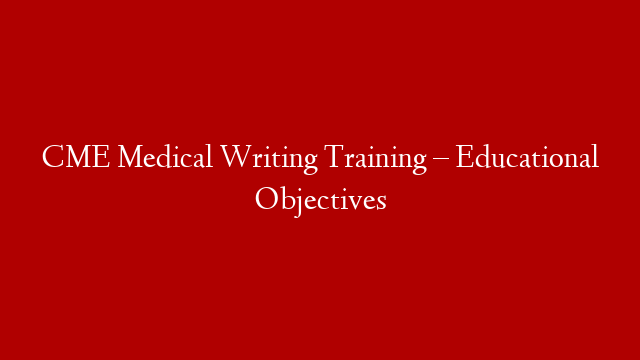THE ROLE OF OBJECTIVES IN MEDICAL WRITING TRAINING
Educational Objectives are among the most important steps in planning a Continuing Medical Education/Continuing Professional Development (CME/CPD) activity. They come from the Needs Assessment, which specifies what physicians need to learn to help improve patient health outcomes. Objectives therefore delineate what physicians will learn by participating in the activity. The Objectives guide the choice of faculty, content, and act as a frame of reference for the activity planners between their intention of the planners and what learning gets accomplished
Objectives are also used when a program is evaluated, to determine if the CME/CPD activity is successful — that is, does the learner’s actual practice improve when they return to their clinical setting. Thus, in the CME/CPD planning process, content is not created in a vacuum, but rather is designed and created with the purpose of meeting the Educational Objectives of the program.
THREE TYPES OF OBJECTIVES FOR PHYSICIAN LEARNING
Educational Objectives should be specific, concrete, and succinct. They can focus on a variety of “measurable” measures: knowledge, skills, attitudes, and practice (long-term future behavior). There are three main types of Objectives, only one of which is truly applicable for CME/CPD:
Learning Objectives – state what the learner will learn or understand by the end of a learning activity.
Instructional (teaching) Objectives – state what the instructor intends to accomplish during a learning activity. This type of Objective describes a process, not an outcome, and is helpful when stated at the beginning of a program.
Behavioral Objectives – state what the learner might do differently (behavioral change) because of what has been learned. This is the type of Objective that must be used to formulate Educational Objectives for continuing medical education (CME/CPD) programs and is the kind medical writers are most likely to be asked to create.
COMMON ERRORS IN CME/CPD EDUCATIONAL OBJECTIVES
Occasionally, clients (and even some CME/CPD professionals) will call all Educational Objectives ‘Learning Objectives’ because they do not know the distinction among the three types. It is also somewhat common to see Learning Objectives formulated for CME/CPD activities instead of Behavioral Objectives. CME certification no longer cares about what the learner will learn. Certification focuses on what the learner will do with the new knowledge or skil. With increasing focus on practice change then, CME/CPD providers are switching to the use of Behavioral Objectives to describe what learners may accomplish by participating in their programs.
OBJECTIVES and the CME NEEDS ASSESSMENT:
QUESTIONS TO ASK BEFORE WRITING
Before writing Objectives, it is helpful to ask a few questions of those involved in planning the activity. Ideally, these questions will have been answered in a well-designed Needs Assessment (a topic for another article,) but if the Needs Assessment has not been completed, or done well, these questions can assist with creating strong Objectives and Program Design. These questions can act as a guide to assuring the Objectives are more meaningful to both the program developers and the learners.
Ask the Client: What course of action, outcome, or change does the Needs Assessment indicate is necessary? Or does the planning committee believe is necessary?
Ask the Faculty: What information can you share to enhance the intended audience’s understanding and competency?
Ask the Target Audience: What do you want the participants to take away from this activity? What would you like to take away from this activity? What do you need that will enhance your practice?
This is the overview of writing Educational Objectives, which is one important piece of designing an educational activity for health professionals. Objectives are one of about seven steps in creating a program, which when completed, create a daisy-chain of steps the create a successful online presentation or live event, for both the CME provider and the target audience.



